According to a Google-commissioned BCG study: companies move through 4 stages of digital maturity, going from “nascent” to “emerging” to “connected” to “multi-moment.”
For B2B companies, the “connected” stage refers to pulling data out of silos and sharing it with the channel platforms that you advertise on. Marketers who have not connected their data risk having the AI assign bids randomly, leading to high cost of acquisition and decreased profits.
By harnessing data models, companies can train their ad channels to effectively retarget audiences with optimized bidding.
In this session, with Glenn Schmezle, Founder and Chief Strategist at Marketing What’s New, you will learn:
- How to combine your internal data with GA4
- Understand ML’s power
- What it takes to leverage it with your retargeting campaigns
[Transcript] You Need To Give Google All Your Audience Data
Although transcriptions are generally very accurate, just a friendly reminder that they could sometimes be incomplete or contain errors due to unclear audio or transcription inaccuracies.
Armando Biondi
A long, long day with lots and lots of great content; this is the last session of the second half of the Ops track. Glenn, no pressure.
Glenn Schmezle
I’m ready!
Armando Biondi
Let’s talk about why you need to give Google or your marketing data. This is a hot take you do not want to miss! Glenn, take it away!
Glenn Schmezle
Sure, I’m probably already getting some people upset just by having a title like that, but give me a minute. Give me a few more than a few minutes, and I’ll tell you why I’m saying that.
So let’s forget about the technical side of how marketing has gone all digital. Let’s just roll back to some fundamentals here for a second.
Let’s talk about how marketing helps a business. So marketing is there, in my view, to be bringing new business in, new revenue. But the cost that you have to spend in order to bring in that new revenue has obviously got to be less than the revenue.
So if people hang around finance folks for a while, they may be used to seeing something like this.
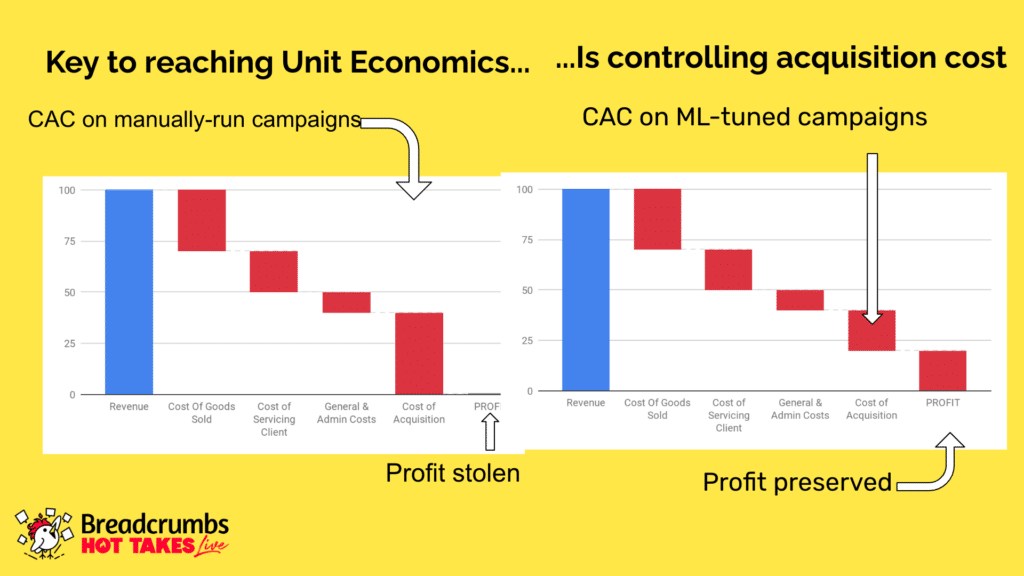
Now, maybe it’s in numbers, but if you plot it out as you’ve got here, if we look on the left, we see here’s this big blue line, how much revenue a business has come in and what we start in our profit and loss is we start to pull out costs.
So we’ve got the cost of the actual goods that you’re selling, the cost of servicing the client; there’s overhead, and then we’ve got this CAC, cost of acquisition or cost of acquiring a customer.
And I think that if marketing is to be sitting at the table and representing things, marketing has to own that cost; marketing should say that they can influence that cost, that they can do it better, and that when new tools come along, that may allow marketing to get that cost down than the rest of the business needs to listen to marketing.
So I think that this is actually an important reason why some marketers gripe about the fact that they don’t get a seat at the table is because they may not be speaking to finance or the rest of the leadership in this way.
But if we can boil down everything that we call a department cost in marketing and we can bring it down on an activity level like a per new customer level, which we call unit economics, then marketing should start to be able to see that as something that they can influence.
Now I want to believe that marketing is an investment, not a cost, but for the sake of this argument, let’s just go with the fact that in the world of how accounting is done, we’re sitting here as the cost of acquisition, but we also can influence revenue.
So this is where I want to take us. Suppose we figure out how, as I’ve got over here on the right, to control those customer acquisition costs, and they become a smaller portion on a per unit basis of every piece of revenue we bring in. In that case, that’s going to leave more room for profit and marketing, at that point, can justifiably say that they led to that.
Alright, so I’m even allowing for the fact that marketing can grow revenue. Of course, that’s true, but in this way of analyzing it, marketing is going to focus on making sure that cost is due. When they preserve the profit, marketing is then the hero of the story, and we get to continue to be a valued member of our company’s leadership.
What does Google have to do with all this? Well, any kind of B2B organization I’ve worked with has data silos, and that data silo is felt when you have a sales org that’s on a different system than marketing’s on and finances even further removed.
So when marketing is trying to bring in new traffic, but they don’t get full visibility into what’s happening post-click, post-conversion, with that traffic, how many of those leads became qualified, became opportunities, became closes, marketing can’t tell those traffic sources, those traffic acquisition channels, whether some of them were worthwhile or not, which ones were worthwhile what was it about the ones that came through that were worthwhile that would make that traffic acquisition channel go look for others like them.
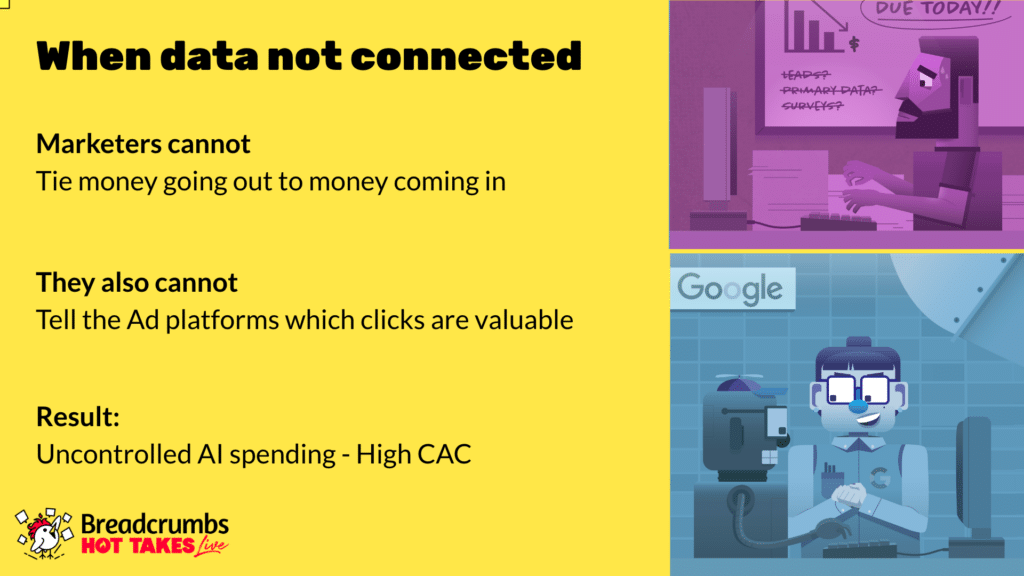
As I’ve got in my little illustration here, on the other side of this equation, we’ve got Google sitting there most notably, who’s saying, “Hey, you don’t have that data; that’s okay I’m gonna figure out how to spend it anyway,” and they do, and that uncontrolled spending by their algorithms translates into an out of control customer acquisition cost.
So it’s not the situation that we want to be in when we’re sitting around the table with the rest of management.
We go into different maturities here, but I want us to focus on the third one here. Where we say we could be connected, this was part of a BCG study that was saying we can get ourselves out of this if we can connect those data pieces.
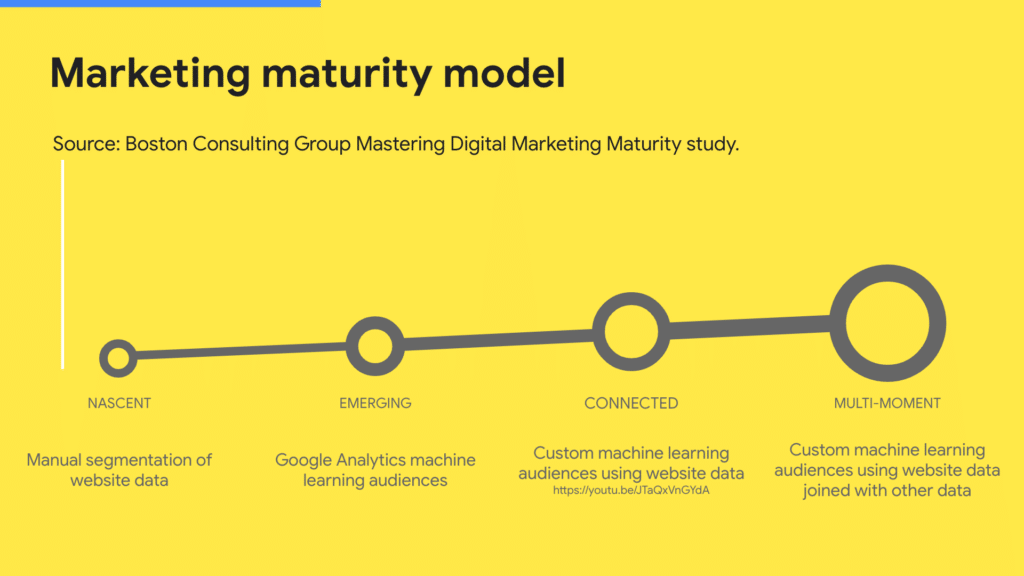
Google Analytics 4, I think, offers a new opportunity for us to do this, and I’m not talking necessarily about the interface part of Google Analytics 4. I’m talking about what we have at the bottom end here, which is Google Analytics 4, available in a raw database format because, through the Google Cloud Platform, we have free access to it, which also allows us to bring in all of our other types of data like I’ve got here on the left of this diagram.
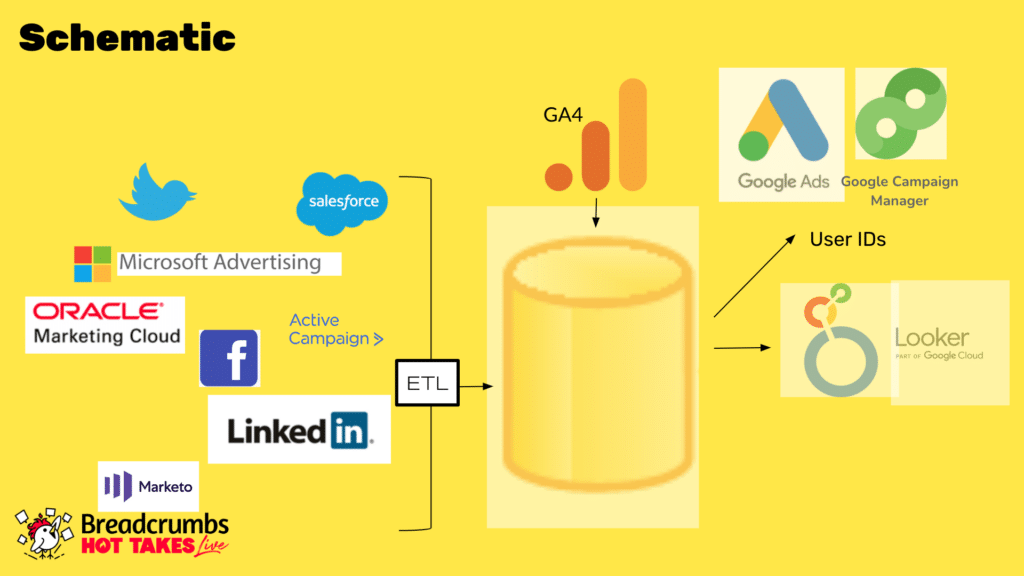
So once you bring in your ad Channel platform and you bring in your marketing automation and your CRM systems, you can feed that information into the Google ecosystem, you’ve got an end-to-end line of visibility for what’s happening. You can feedback, from deep in the funnel, on the things that made certain customers your high value or your high close rate customers, and you can inform Google ads and the other Google Display and Video 360 and others of what it was about them.
I want to be clear here because I fudged a little on the title; you’re not giving them all the data, you’re not giving them the person’s name, and it’s not personally identifiable. You are giving them a user ID, but to them, that’s just as valuable. What that makes possible is that you can get the Google picture taken care of.
On the downside, you will have to do a little bit more work if you’re not trying to feed it to Google; if you’re trying to feed it to LinkedIn or Microsoft or Meta or some of these others, Google will tell you like Mufasa did, “Oh, don’t worry about that over there that’s not part of your domain.”
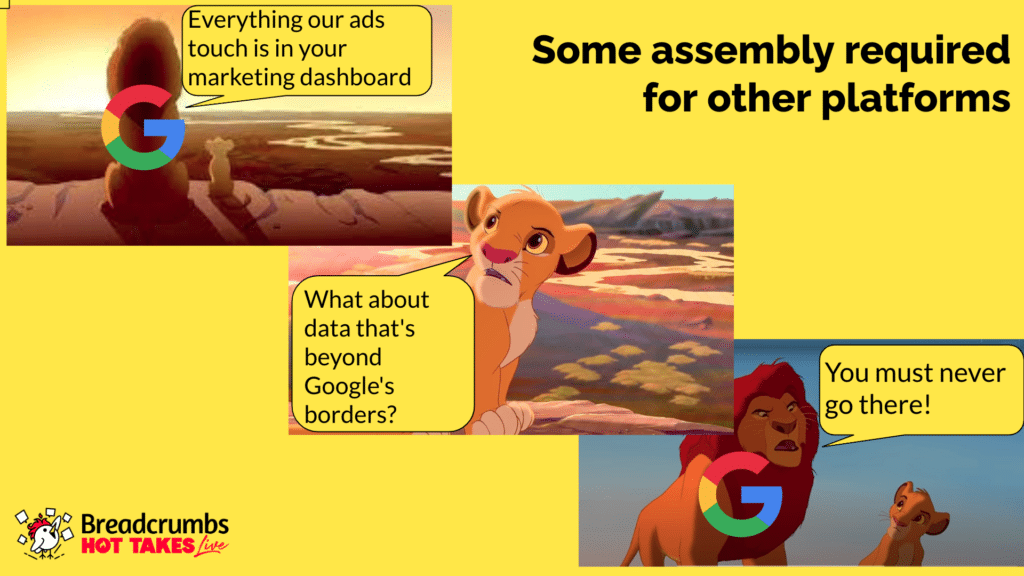
However, you can still do it using some third-party tools, I’d be happy to talk to you about that later. I think the case can be made that you should share your information with Google so that you can answer questions like I’ve got here.
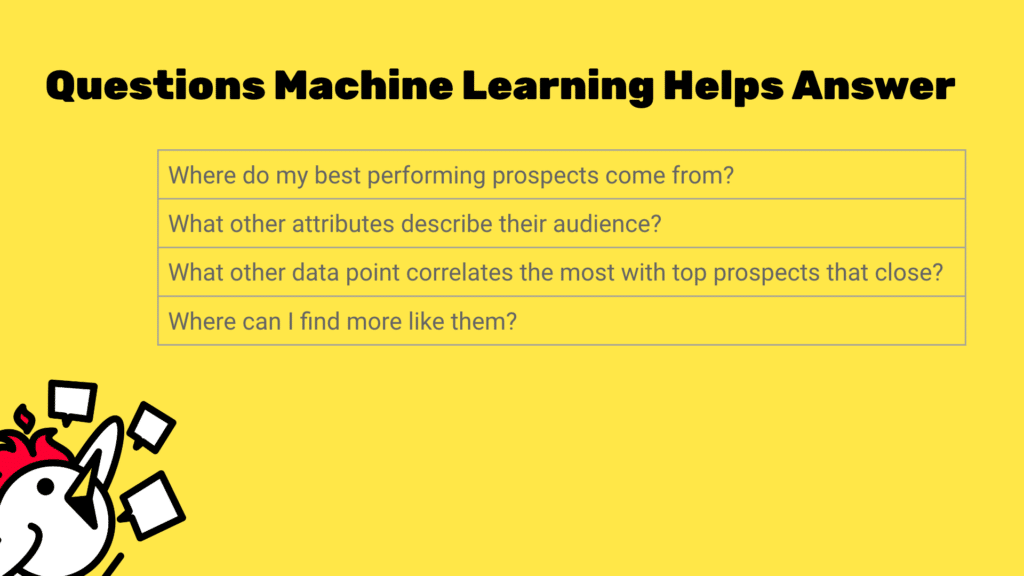
Google will start to understand which are the best performing and what are the other attributes of those people that it knows about we may not know about, which allows it to go after more like them when and where they are, what Google products they are using when they’re most susceptible or interested in the message that you carry.
So it will know how to use that information using its AI, and I’ll leave it right there thank you so much for your time.
Armando Biondi
Thank you, Glenn. Love it! If there are questions from the audience, feel free to write them in the chat, and we’ll pick them up from there.
Actually, there is one from Carol already which is asking whether you’re talking about the Google click identifier or something else within GA4.
Glenn Schmezle
So, yeah, they don’t make it easy. There is something called a g-click ID or GCLID, and that is specifically if it was draw-driven from Google ads. So yes, that is an important one; there is another user ID that you may have if you have an app or if you have a SaaS platform where there is a session identifier that allows you to connect it back to their subscription or other record information that you have.
Maybe they’re on a trial, so you can use a number of those, but yes, the one that would be most valuable to Google Ads would be the GCLID.
Armando Biondi
Okay, so that is what you were talking about exactly.
So a couple of reactions from my side. I found this topic particularly intriguing because people would think that you’re crazy saying something like that. It’s a very controversial statement, which I love.
But it does make sense because the underlying assumption as far as I can tell, that you’re kind of advocating for is the fact that Google is always going to be better at connecting data with outputs than you are going to be in any circumstance, pretty much. Would you agree with that? Is that like in the underlying assumption did I read that correctly between the lines?
Glenn Schmezle
If you and I were talking about this ten years ago when AI was more of a theoretical, we would probably have agreed and said there’s going to be a company that will have this capability. And I think Google is pretty much there; they shrouded in secrecy, they black box it, that annoys me.
However, if I look at the way that they’re designing campaigns today, the majority of them, and the ones that we are being steered towards, are driven by AI, and they would not bet the farm on AI unless they were convinced that their algorithm can really do it right, they have to report public numbers.
Armando Biondi
There’s an actual ROI that works at scale for pretty much everyone, and it’s also like a flywheel growth engine for them to grow for the next 15-25 years.
Glenn Schmezle
That’s their gambit, and it’s an auction environment, so let’s never forget that if our competitors are going there before we are, then we will be at a disadvantage in the auction.
Armando Biondi
So where does the being a plus Open AI relationship land versus Google? Lots of people are talking about, “Oh my God, Google is in danger, existential danger because of this.” What’s your take? Is that the case?
Glenn Schmezle
Two parts to the answer. So number one, and I’ve even spoken to people directly at Google and at Microsoft about this, and they agree that if you are speaking to one of those ad platforms, their system works best when you provide them that information.
And I’m happy to say that there are ways to do exactly what I’ve described with Google, with Microsoft ads, and with LinkedIn. They’re out there.
The other thing that they will say, under their breath, is that what they’re not good at is understanding multi-touch attribution if it goes outside of their walls. So a marketer still has, I think, the responsibility, when they’re slicing the pie on owned media, to figure out what channels are deserving of money at certain points in their funnel and that we still have to manage.
Armando Biondi
That integrated approach between the Microsoft and the Google of the world and every other channel that might be relevant to you essentially.
Glenn Schmezle
We have to almost be the referees in the game.
Armando Biondi
Which is a fair point on one end. On the other end, it’s kind of the black hole of marketing. Multi-touch attribution like this unicorn that no one ever resolved in a satisfactory enough way, I love it.
Glenn Schmezle
I think my point here is that where you go crazy is when you try to drill it down to too small a level like individuals, and as we know, with privacy, we won’t be able to do that. So just keep it in aggregate.
Again this is why something like unit economics, where you try to use rough numbers, it’s a model.
Armando Biondi
Give us your reaction on this one as a way to back up this session.
So when it comes to multi-touch attribution or attribution in the general part of the problem, from what I can tell, is that attribution is really a story based on a certain number of data points that you want to prioritize or put a premium on.
So that story might change based on the data points that you’re looking at, and different stories or like different storylines tell the overarching narrative kind of looking at an elephant and touching the leg a little bit and the tail a little bit.
Glenn Schmezle
So whether we’re worrying about from first to last click, or you’re doing like the media mix model, or you’re doing incrementality, you’re right. All of them, it’s like glasses. It’s a lens and does the lens drive with what you know when you walk around, and you hear how clients became clients, and if it’s helpful to you in those ways and I think it will be you can make better decisions.
Armando Biondi
Well, thank you so much, Glenn, and thanks everyone for watching.
Glenn Schmezle
Thank you so much very much appreciate it.
